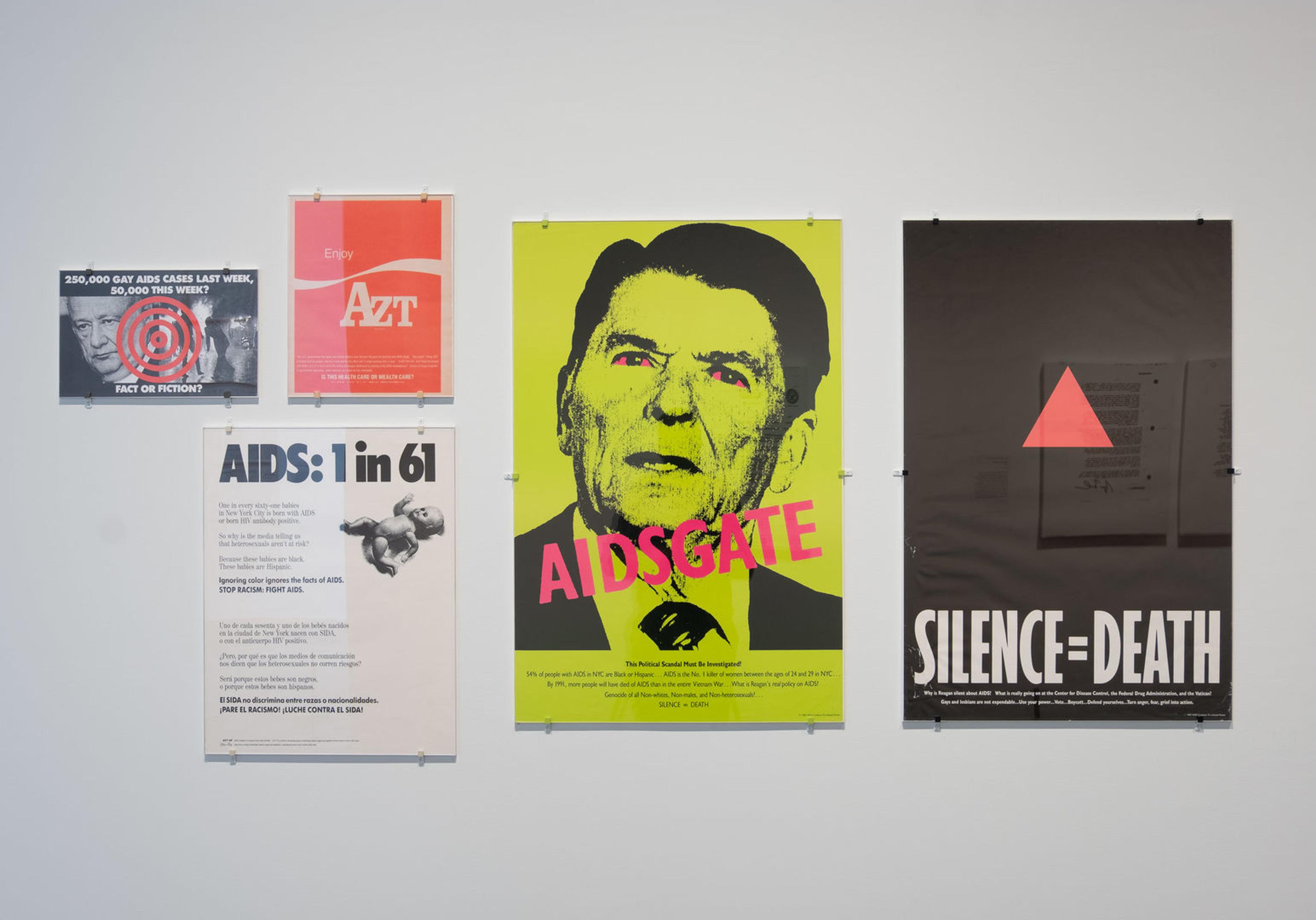Today marks World AIDS Day, a global health initiative started in 1988 by the World Health Organization to unite people across the globe in the fight against HIV/AIDS and to commemorate those who have died from AIDS-related illnesses. This year's theme, Know Your Status, is designed to reach people living with HIV who do not know their status and ensure that they are linked to quality healthcare services.
Included in The Met Breuer's current exhibition Everything Is Connected: Art and Conspiracy is a selection of protest posters created in the first decade of the AIDS epidemic by members of two political collectives, the Silence = Death Project and Gran Fury, the latter of which served as the artistic arm of ACT UP (AIDS Coalition to Unleash Power), an advocacy group the activist Larry Kramer helped to form in March 1987 to drive visibility of the ongoing crisis and spur political action to find a cure.

Installation view of Everything Is Connected: Art and Conspiracy, on view at The Met Breuer through January 6, 2019. See below for artwork credits.
As with many objects consigned to white walls in an art museum, these posters speak of another time: in this case, a time in which stigma, fear, and panic ran rampant as people tried to make sense of the mysterious, devastating virus sweeping the world; as political commentator William F. Buckley Jr. recommended gay men with AIDS be marked with tattoos denoting their status; and as Ronald Reagan, the president of the largest superpower in the world, failed to utter the word "AIDS" in public for years, at which point the disease had already claimed more than 5,600 lives.
Thirty years after these fiery images were designed as agitprop—pasted on the streets of Manhattan and used in key protests and demonstrations against the United States government and the pharmaceutical industry—it seems perfectly natural to look at them and think of the very particular point in time they represent.
What needs to be recognized on a much greater scale, however, is that the time they represent is also today.
Although HIV/AIDS is now considered a manageable disease and the number of deaths has dropped by about fifty percent from an all-time high of 1.9 million in 2004, the path to treatment remains difficult to impossible for those without proper access to healthcare, and the rate of infection among gay and bisexual men of color, as well as adolescent girls in sub-Saharan Africa, remains high. Even in the United States, the Presidential Advisory Council on HIV/AIDS was shuttered earlier this year after half of the members resigned in protest over the administration's distance from the issue.
Statistics speak from themselves. According to the most recent data from the Joint United Nations Program on HIV and AIDS (UNAIDS):
- 36.9 million people globally were living with HIV in 2017, 1.8 million of which were children under the age of fifteen.
- 1.8 million people became newly infected with HIV in 2017.
- 940,000 people died from AIDS-related illnesses in 2017.
- 77.3 million people have become infected with HIV since the start of the epidemic.
- 35.4 million people have died from AIDS-related illnesses since the start of the epidemic.
So on this World AIDS Day, view these protest posters on the gallery wall and reignite the power of their imagery with context—the seething anger and unbridled fear that fueled their creation—and their current relevance. The work of the Silence = Death Project and Gran Fury should not be interpreted as relics of the past, but as visceral reminders that HIV/AIDS still ravages populations across the world and continues to be neglected by a number of our most important institutions.
Related Content
Everything Is Connected: Art and Conspiracy is on view at The Met Breuer through January 9, 2019.
The exhibition catalogue, by Douglas Eklund and Ian Alteveer with contributions by Meredith A. Brown, John Miller, Kathryn Olmsted, and Beth Saunders, is available in The Met Store.
Above image, from left to right: Avram Finkelstein (American, born 1952) and Donald Moffett (American, born 1955). Fact or Fiction, 1989. Offset lithograph, 8 5/8 x 13 5/8 in. (21.9 x 34.6 cm). The Metropolitan Museum of Art, New York, Purchase, Stanley Posthorn Gift, 2018 (2018.225). Gran Fury (active 1988–1995). AIDS: 1 in 61, 1988. Offset lithograph, 22 x 17 in. (55.9 x 43.2 cm). The Metropolitan Museum of Art, New York, Purchase, Stanley Posthorn Gift, 2018 (2018.224). Avram Finkelstein (American, born 1952) and Vince Gagliostro (American, born 1954). Enjoy AZT, 1990. Offset lithograph, 13 1/2 x 11 1/4 in. (34.3 x 28.6 cm). The Metropolitan Museum of Art, New York, Purchase, Stanley Posthorn Gift, 2018 (2018.226). Silence = Death Project (American, founded 1987). AIDSGATE, 1987. Lithograph, 33 3/4 x 22 1/8 in. (85.7 x 56.2 cm). The Metropolitan Museum of Art, New York, Gift of Avram Finkelstein, 2013 (2013.973). Silence = Death Project (American, founded 1987). Silence = Death poster, 1986. Offset lithograph, 34 x 24 in. (86.4 x 61 cm). Avram Finkelstein Archive, Fales Library, New York University
